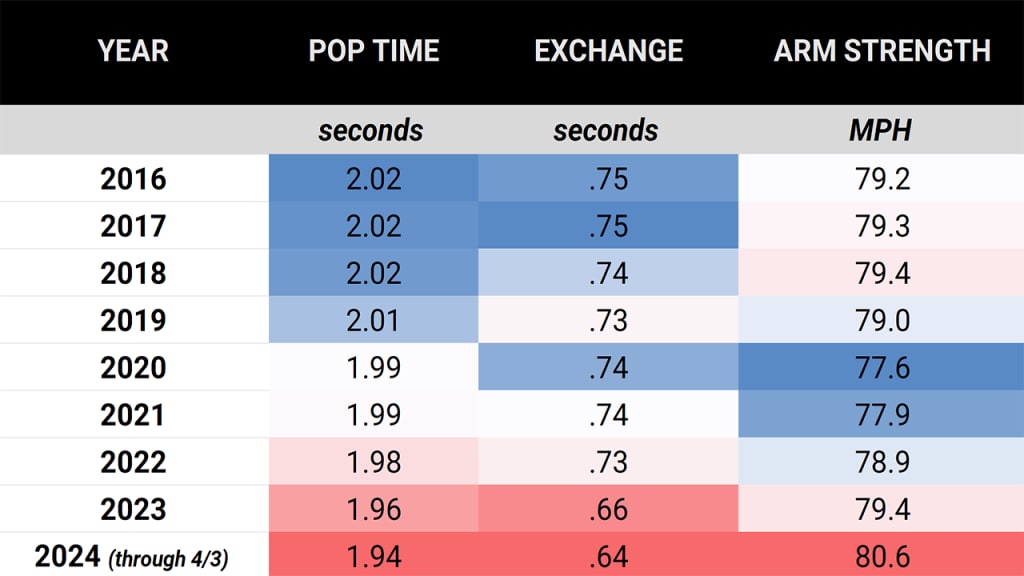A week into the season, it’s hard to make any grand sweeping proclamations. After all, some teams haven’t even played 5 percent of their schedule yet -- there’s so, so much more baseball to come. (Hooray!) That said, it doesn’t mean that we can’t make some takeaways about what’s happening in 2024, either. What’s been interesting so far? Here’s seven of our favorites. (All numbers current as of April 5.)
1. Splitter season is here
Back in January, we made note of what seemed like it would be 2024’s most obvious upcoming trend -- that if 2023 was about the sweeper, then 2024 was going to be about splitters, marking a triumphant return for “the pitch of the 1980s.” That was partially about the obvious influx of Japanese pitchers who brought one, and indeed, we’ve seen Shota Imanaga, Yoshinobu Yamamoto and Yuki Matsui throw their splitters more than a quarter of the time.
But it wasn’t just that, either; it was also about the fact that they’re extremely effective, have little platoon split, and, perhaps most importantly, have collected no actual evidence that they cause injury nearly as much as was believed decades ago, leading to their decline.
All spring, we heard pitcher after pitcher talk about how they were planning to add one to their repertoire this season. So far, we’ve seen Bryce Miller, Jordan Hicks, Hunter Greene, AJ Puk and others follow up on that plan.
So, a week into the season, has that overall prediction paid off? It seems so.
Splitter usage, MLB:
- 2024: 3.3% <<--
- 2023: 2.3%
- 2021: 1.6%
- 2020: 1.6%
Three point three percent of all pitches may not seem like a large number; on the other hand, that’s twice as many as there were two years ago. If this rate continues, we’d see about 7,000 more splitters this year than we did last year. It’s so many splitters. Splitter season is on.
2. Guess what: Fewer fastballs, thrown harder
“Fewer fastballs are thrown, but the ones that are thrown are thrown with higher velocity” is such a regular occurrence right now that it barely seems worth pointing out -- it’s obvious. Yet, since we’re here … it’s happening again. You know all this, so, let's do this one quickly.
Four-seamers and sinkers are being thrown just 46.7% of the time, another new all-time low, and down from a pitch-tracking-era peak of 58.4% in 2009. The Red Sox are throwing four-seamers and sinkers only 29.9% of the time, which would be by far a new all-time low, and imagine that for a minute: Seven of every 10 pitches they throw are not four-seamers or sinkers.
When you do get a fastball, they’re thrown hard, with the 2024 average of 93.7 mph being just a tick behind last year’s 93.9 mph for the all-time (tracking-era, since 2008, but also come on, all-time) record. It feels like this trend might never end.
3. Willson Contreras has joined the one-knee down catching revolution
For years, Contreras was respected for his strong bat and even stronger throwing arm, but his overall value was somewhat muted because of a relatively poor track record of pitch framing. Dating back to 2016, Contreras was rated as having cost his team 20 runs just on framing, putting him near the bottom of the list of backstops in that regard. Midway through last season, his first with the Cardinals, The Athletic reported that he began incorporating the one-knee-down stance in an attempt to improve his framing.
So far, so good? Look at Contreras’s rate of turning takes on the edges into called strikes.
- 2022: 46%
- 2023: 44%
- 2024: 52% <<--
That's not just better. It's actually good.
It’s specifically notable if you look at the bottom-middle edge of the zone, which is largely where this approach helps to improve framing. The increase has been huge.
- 2022: 43% called strike rate
- 2023 (first four months): 38%
- 2023 (last two months): 43%
- 2024: 58% <<--
You can see it in action, just in the first few games of the season:
“I set a goal this year of whether I’m hot or not hitting, behind the plate and with our pitchers, I need to be one of the best [defensively],” Contreras said earlier this week. While his St. Louis tenure got off to a rough start, it was also easy to notice that he was the best-hitting catcher in the game from July 1 onward last season.
4. Julio Rodríguez is off to a great start -- on defense
Rodríguez isn’t off to a fast start with the bat -- he’s slashing just .185/.241/.222 -- but a big part of why he got some preseason Most Valuable Player hype is that while you know the bat will be there, he’s never quite gotten the attention he deserves on defense. That’s in part because it wasn’t clear he could even handle center field; coming up as a prospect, he often played in a corner. “I know everyone was [initially] worried about him playing center,” three-time Gold Glover Mike Cameron said to The Seattle Times last summer.
But Rodríguez rated well in his first two seasons, posting +9 outs above average in 2022 and +12 in 2023, placing him fifth-best across the two seasons combined. Then, on April 1, he made two of the finest-rated catches of the young season -- robbing Will Brennan each time.
In the second inning, Brennan hit a ball a projected 397 feet away. Rodriguez had 4.9 seconds to run 85 feet, and with an adjustment for direction and the wall, he made a play that is converted only 35% of the time.
In the fourth, he outdid himself. This time, it was a sinking liner away from him, giving him 60 feet to run in just 3.6 seconds. That’s a play that’s even more difficult to make -- it had only a 15% catch probability -- but it wasn’t elite speed so much as it was a great reaction that allowed him to do it. Rodriguez got off to a jump seven feet better than average (that’s feet traveled in the right direction in the first three seconds), which put him in position to even be able to make the sliding catch at all.
"I saw Julio in the Dominican Summer League [in 2018] and I never thought for one second that he was going to be a center fielder," said scout José Gómez Frías, speaking to FOX last year. Six years later, he’s not just a center fielder. He’s a great one -- and it might just help make him an MVP.
5. Maikel Garcia’s breakout is already in progress.
Garcia was a popular breakout pick before the season, despite an unimpressive .681 OPS last year for the last-place Royals. It’s almost hard to sum up all the reasons why, because there were so many. He’s young (24), and he stole 23 bases last year. His elite best-in-the-AL third base glove (+13 outs above average last year) won’t by itself improve his bat, but would at least buy him plenty of time to get the offense going. And, of course, there’s the 93rd percentile hard-hit skill -- while he put it on the ground too much, he also had a better hard-hit rate than Austin Riley or Vladimir Guerrero Jr.
Plus, while you generally don’t want to put very much emphasis at all on non-regular-season stats, it was at least nice to see that Garcia had a 1.117 OPS in winter ball in Venezuela, then a .984 OPS in Spring Training. Can't do that hitting the ball on the ground, right?
Given all that, it might be easy to look at Garcia hitting .267 with a .281 on-base percentage and think that nothing has changed. Think again. His six extra-base hits are tied for third-most, but what’s most encouraging to us is his barrel rate (barrels are a type of batted ball that are the perfect combination of exit velocity and launch angle, important for a hard-hitter who hit too many grounders last year).
- 2023: 13 barrels in 857 swings
- 2024: 6 barrels in 64 swings <<--
Last year, he had a barrel once every 66 swings. So far this year, it’s once every 10 swings. “It’s still early” still applies, and the low OBP remains a concern. But the defense already looks elite again, and the power looks real. The breakout isn’t coming. It’s happening.
6. Look at Seiya Suzuki and Fernando Tatis Jr. setting personal exit velocity records
Suzuki, like Garcia, was something of a popular breakout pick, in part because he was the second-best hitter in baseball after his summer benching last year, then mashed six homers in Spring Training. While the stat line early on is more good than great, it’s also worth noting that in his three seasons in the Majors, Suzuki has swung more than 1,700 times, and two of his four hardest-ever hit balls came in the last week.
Suzuki’s hardest-hit balls
- 115 mph: homer, April 2, 2024 <<--
- 114.6 mph: single, July 18, 2023
- 113.2 mph: single, May 30, 2023
- 112.8 mph: single, March 31, 2024 <<--
That seems more than a little promising, and we might say the same for Tatis, who has been around even longer -- he’d played 414 Major League games entering the season -- and set a new personal best (by, to be fair, all of 0.1 mph) when he roped a single to left field against the Dodgers.
None of this guarantees great seasons are incoming, of course. But after hundreds of games, any time you can set a new best? It’s at least interesting.
7. Catchers might -- might -- be focusing more on stolen base prevention
After a season when (thanks to rules changes) the Majors set the all-time record for stolen base success rate, we figured we’d see teams being more aggressive on the bases this year. After all, Trea Turner going a perfect 30-for-30 last year sounds great, but it’s easy to argue that it’s not -- if you’re never being caught stealing, then you should probably be stealing more.
At least in the first week of the season, that hasn’t happened. Last year, there was just less than one stolen base attempt per team game -- 4,369 attempts in 4,860 team games, or 0.9 attempts/game. This year, that’s 166 attempts in 202 team games, or 0.82 attempts/game. It’s less. It is, again, early. The weather has been bad. Some speedy players like Evan Carter have barely been on base, limiting their attempts to steal.
It might be nothing. But it also might be this, too. Just look at what catchers, early on, are doing.

They're hustling, is what they're doing. Or, perhaps, it's a little about who is doing the catching, because if you look at last year's five slowest throwing catchers, two (Mike Zunino, Yasmani Grandal) haven't played in 2024, and the other three (Logan O'Hoppe, Victor Caratini and Keibert Ruiz) have combined for four attempts against them. Meanwhile, the inability of A's pitchers to hold runners on has meant plenty of attempts for Shea Langeliers, one of the best throwing catchers in the game.
But even Ruiz has sped up, improving his pop time from 2.06 to 2.01. It might be that catchers saw what was happening last year and realized that it was up to them, that they have to be just a tick faster. So far, it's working.
